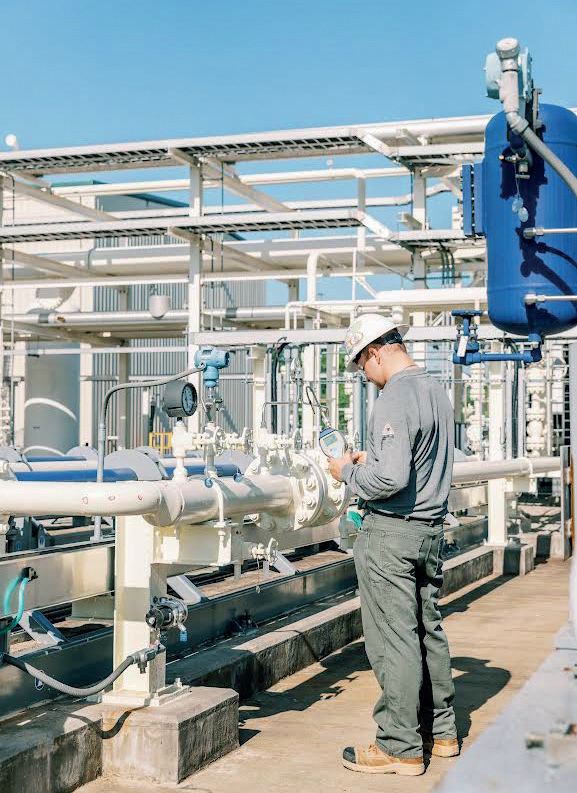Differentiated natural gas provides the oil & gas industry with the opportunity to join the low-carbon economy and gain market share. Existing programs and frameworks like OGMP 2.0 can help companies get on the fast track.
By Angelique Giraud, Lauren Sion, and Melissa Dakas, Montrose Environmental
Oil & Gas in the Energy Transition
The energy transition is happening now; while the increasingly climate-conscious world may initially appear as a threat to the oil & gas industry, in reality, it provides a market opportunity on which the industry can capitalize. Disclosure of emission reduction initiatives and net zero intentions is becoming more common within the industry. However, declaring net zero goals is not enough to differentiate product and maximize market share; emission reduction claims require action and evidence. Continuing with status quo practices lacking transparency risks asset value.
By modifying operations and approaches to emissions measurement, the oil & gas industry can be a key player in the transition to a low-carbon economy. This also allows the industry to avoid the future risk of potentially stranded high methane intensity assets, therefore retaining the value of investments. In May 2022, the Environmental Defense Fund (EDF) released a white paper addressing the merits of a strong and meaningful differentiated natural gas program. Although a relatively new concept, the role of differentiated natural gas in the low-carbon energy transition will continue to expand. These programs provide oil & gas companies with an opportunity to significantly reduce climate impact through methane measurement and mitigation. Differentiated natural gas can also serve as a market signal within the industry, as customers demand low-carbon alternatives.
Differentiated Natural Gas: What It Means And Why It Matters
Differentiated gas, also referred to as certified gas or responsibly sourced gas, is natural gas which has been produced in a manner that minimizes methane emissions (consistent with society’s call to address the climate crisis) and has undergone a third-party review confirming that relevant standards are met. Currently, there are several programs available for natural gas certification. Oil & gas companies can choose to pursue certification as part of corporate sustainability initiatives or to sell to gas purchasers with common climate goals with a price premium.
Due to the industry’s large contribution to climate change, oil & gas companies have often been accused of greenwashing, or conveying a false impression about environmental consciousness. Published certification programs provide an opportunity for these companies to avoid greenwashing in their methane mitigation efforts by leveraging comprehensive and accurate emissions monitoring data and transparent reporting.
The Elephant in the Room: Methane
Methane is a greenhouse gas (GHG) with a high global warming potential that can be released unintentionally or routinely vented throughout the value chain. Methane is a main component of natural gas, so not only are these releases harmful to the environment, but they also represent a lost product that could have otherwise been sold for profit.
The oil & gas industry is massive, and the equipment that produces and transports gas is complex. Legacy technology and equipment were developed on an assumption that there is an abundance of energy resources, and without the understanding that methane has an outsized impact on climate change. Additionally, across the industry, methane emissions are typically estimated using general published emission factors assuming each piece of equipment releases a uniform amount of methane in a given timeframe. These factors do not consider operational differences among distinct operators, sites or equipment, and whether those differences come from intentional emission reduction projects or equipment malfunctions resulting in unplanned venting events. However, as understanding of climate change has progressed, technology to detect and measure GHGs has similarly advanced.
Satellites, drones, optical gas imaging (OGI), and continuous monitoring allow methane and other GHG emissions to be identified and quantified – sometimes without the need for personnel to set foot in the field. With this direct measurement technology becoming more widely available, it is clear that
industry estimates of GHG emissions are often extremely inaccurate; a 2015 study reported that U.S. oil & gas industry emissions were up to 60% higher than the United States Environmental Protection Agency (USEPA) reporting indicated.
The industry has an opportunity to get on the right track – at the perfect time. There are several programs that provide transparent certification of responsibly sourced natural gas, including MiQ, Equitable Origin, and the Oil and Gas Methane Partnership 2.0 (OGMP 2.0). Continue reading to learn more about details of OGMP 2.0, outlining what this framework involves, the benefits that it provides, and how fugitive emissions detection technology such as OGI plays a key role in the realm of differentiated natural gas.
Partnering with OGMP 2.0: A Trusted Framework
OGMP 2.0, noted in the EDF white paper as a high-integrity monitoring and reporting framework, provides in-depth methodology for companies to measure emissions more accurately and transparently report them, while also committing to emissions reductions. This multi-stakeholder initiative, launched by the United Nations Environment Programme (UNEP) and the Climate and Clean Air Coalition, outlines methane emissions measurement and reporting requirements for the oil & gas industry at both source- and site-level, combining bottom-up and top-down approaches to include direct quantification of methane emissions, and thus moving away from the use of inaccurate emission factors and estimates. OGMP 2.0 is more than a reporting framework; it also provides a community of practice for like-minded companies to share experiences regarding methane quantification and reduction during periodic collaborative working sessions.
Companies joining the OGMP 2.0 sign a Memorandum of Understanding (MoU) with the UNEP, committing to the OGMP 2.0 framework. Once the MOU is signed, member companies work to set methane reduction targets, develop implementation plans to achieve OGMP’s Gold Standard within three to five years, and report actual methane emissions from all material sources (both operated and non-operated assets) on an annual basis. Gold Standard reporting indicates that measurement-based, source-level emission data are reconciled with independent site-level measurements, typically from fixed-base sensors, verifying data integrity. OGMP 2.0 is just one framework that provides companies with a clear protocol on how to build and implement an accurate and transparent GHG quantification program that is also customizable and conforms to current regulatory and operational requirements. There is no fee to join OGMP 2.0.


The Role Of Fugitive Emissions Detection Technology In The OGMP 2.0 Framework
A major purpose of the OGMP 2.0 framework is to encourage direct measurement of methane emissions whenever feasible. Direct measurement is favorable to the uncertainty of traditional methane quantification methods such as emission factors. OGMP 2.0 has developed Technical Guidance Documents for each of the core methane emission sources. These documents provide examples of suitable quantification technologies, but they recognize that similar or superior alternative methods may be used based on feasibility and availability. Operations can vary between companies and facilities, so OGMP 2.0 encourages member companies to select the most effective technologies for their source and operating conditions.
Multiple types of fugitive emissions detection and quantification technologies are integral to direct measurement of methane emissions. Leak detection and repair (LDAR) surveys, whether traditional (Method 21) or using OGI, are the first step to properly identifying methane leaks at a site. Under the current regulatory reporting programs, the number of leaks can be used along with a source-specific leak emission factor, the number of hours leaking, and the methane concentration of the gas to quantify emissions. OGMP 2.0 takes LDAR programs a step further, requiring quantification of leaks to create an accurate inventory of methane emissions from this source type. With one added step to an existing LDAR program, a hi-flow sampler or other accepted quantification technology can quantify the flow rate of a fugitive emissions leak. A representative sample of leak rates can be used to develop measurement-based emission factors for common systems which consider component type, environmental, and operating conditions to classify populations of components.
Gold Standard reporting combines emissions reported by source type (Level 4) and adds site-level measurements (Level 5). Site-level measurements typically involve continuous sensors or satellites that capture a complete overview of emissions across an entire facility. These sensors can be stationary or mounted on planes, drones, trucks, or other vehicles. Continuous monitoring allows the member company to reconcile emission estimates, identify and repair leaks more quickly, and verify source-level measurements.
Transparency In Emissions Reporting
Committing to a responsibly sourced gas certification program or framework such as OGMP 2.0 illustrates the highest commitment to transparently and accurately measuring and reporting actual methane emissions, as well as a commitment to emissions reduction. Measurement technology allows oil & gas companies to take an accurate snapshot of methane emissions and provides the opportunity to develop robust plans to reduce emissions from the most material sources, increase process efficiencies, and disclose emissions in a more transparent manner. Differentiating natural gas sets products apart, helping to maintain and grow market share through the low-carbon energy transition.






References
- Assessment of methane emissions from the U.S. oil and gas supply chain https://www.science.org/doi/10.1126/science. aar7204?siteid=sci&keytype=ref&ijkey=42lcrJ%2FvdyyZA
- https://www.ogmpartnership.com/templates-guidance

